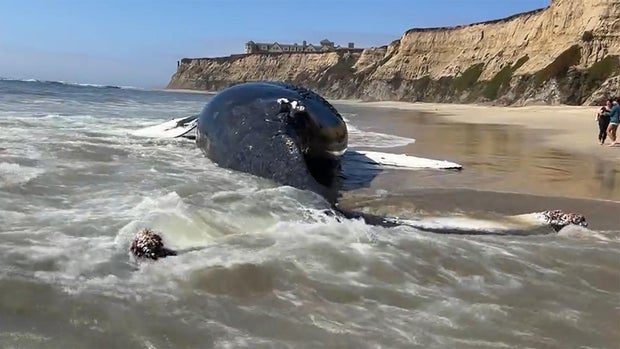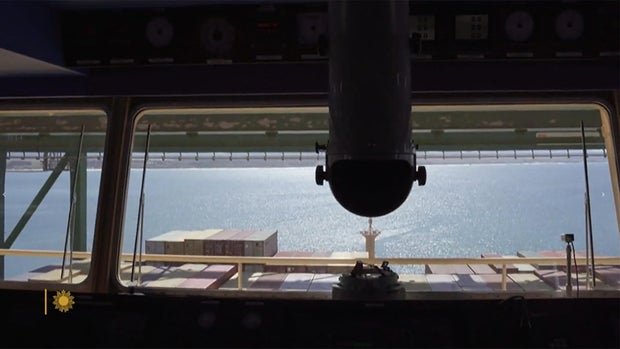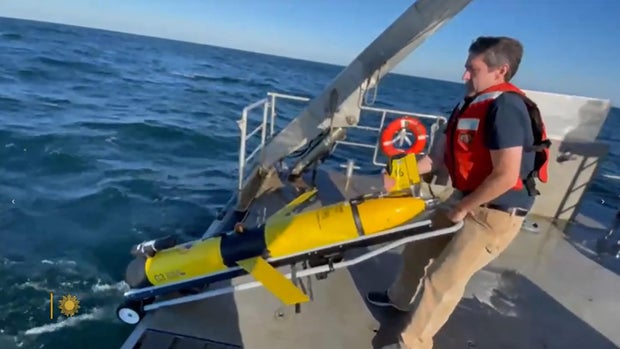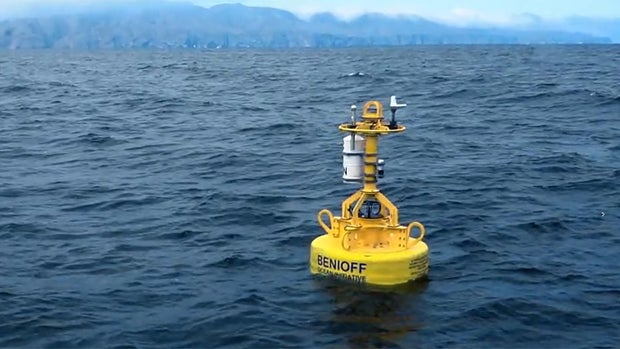In the summer of 2022, I was walking on the beach at Half Moon Bay in California, when I saw the strangest thing approaching on the waves. When it struck the shore and deflated, I knew: it was a dead whale.
But it wasn’t just any whale. It was Fran.
“I knew this whale, and I’m like, Ohhhhh. It just hit my heart, because Fran, at the time, she was the most well-known whale in our entire database,” said Ted Cheeseman, the creator of HappyWhale.com. That’s a database of whale sightings, which includes more than 850 pictures of Fran the humpback whale, identified by her tail markings.
CBS News
“She had a big personality,” said Cheeseman. “She was playful around whale watch boats. You know, you’d hear on the radio, ‘Hey, Fran’s over here!’ ‘Oh cool, you know, let’s go hang out with Fran!'”
Fran had a baby, known as Aria, who was now orphaned. “We didn’t know if the calf could survive,” Cheeseman said. “I didn’t think so. I didn’t think it was very likely.”
Fran died from a collision with one of the cruise ships and container ships that make more than 200 million trips a year.
According to Sean Hastings, a policy manager for the National Oceanic and Atmospheric Administration (NOAA), ship strikes and entanglements in fishing gear were the number one and number two threats to whales.
Nobody knows exactly how many whales are ship-strike victims every year, because most of them sink after they’re hit. But blue whales, humpbacks, and fin whales are on the endangered list, and the Northern right whale is just about extinct – only about 350 of them are left on Earth.
“That’s why every whale counts, so that we can bring their populations back and help them recover,” Hastings said.
The good news is that the shipping companies themselves say they care.
“There’s no one in our industry that wants to see any one of these magnificent creatures harmed or killed by anything we do,” said Bud Darr, policy director for the world’s largest shipping company, MSC.
He showed me why ship captains can’t just steer clear of whales. The bow of even one of MSC’s smaller container ships is hundreds of feet away from where the captain sits. And even if you could spot a whale ahead, there’s not much you could do about it.
“The ship is an extremely large object,” said Darr. “It’s moving very fast, and it’s noisy. I mean, you may not know there was impact with a whale at all, if there was. Unfortunately, we’ve had whales that have remained on a bulbous bow of a ship when it’s come in.”
CBS News
One obvious solution: Move the shipping routes. Darr said, “Off of Sri Lanka, we realized if we could just move where we operate, about 15 miles further offshore from where that was, you could reduce the risk [of strikes] by 95% or more.”
But the approach channels to most ports don’t have the room for rerouting. So, the second-best Idea is to slow the ships down, from about 18 mph to 12 mph. Hastings said, “By slowing ships down, it gives the whales more opportunity to get out of the way. And in the event that they are struck, there’s a higher likelihood of survivorship. This is much akin to having a slow-speed zone around a school.”
There’s an emissions payoff for the ports, too. “Slower ships emit less air pollution, and reduce the amount of greenhouse gases they emit out of their stacks,” Hastings said.
But rerouting and slowing down both require a key piece of data for the ship captains: Are there whales ahead? And that’s where technology comes in.
At the Woods Hole Oceanographic Institute, marine ecologist Mark Baumgartner’s lab operates a fleet of autonomous vehicles called Slocum Gliders that “fly” beneath the waves listening for whale song.
CBS News
“Every two hours, the vehicle comes to the surface, uses the antenna to send all that information home to a computer in my lab,” Baumgartner said.
He’s also deploying an array of microphone buoys. The whole point of all these machines is to listen for whale song.
Ship captains receive word of the whale locations from the buoys and gliders so they can slow down. But on the West Coast, slowing down is voluntary.
CBS News
At WhaleSafe.com, you can see the paths of the ships … the locations of the whales … and letter grades for shipping company compliance. About 30% of them still plow ahead full-speed, ignoring the warnings.
MSC’s Bud Darr can tell you why: “There is some impact on the schedule. There is some impact on cost that probably comes with that. And that takes a lot of sophistication and planning to mitigate that and get that right. But most of these solutions are manageable.”
Compliance is also voluntary on most of the East Coast, so ships continue to kill Northern right whales. NOAA has proposed a regulation that would make the slowdowns mandatory in more areas.
Mark Baumgartner is cautiously optimistic: “If I didn’t have a little bit of hope, I’d just go home and curl up in a ball and be done with it,” he said. “So, it helps keep me going.”
Well, maybe this will cheer him up: Remember Aria, Fran’s baby whale? Whale tracker Ted Cheeseman received a phone call from a naturalist: “He says, ‘Hey, Ted, I think I’ve seen Aria just now. Can you confirm this?’ And then he texts me a photo. I confirmed. I was like, ‘Yes! So exciting! Aria’s alive!
“Hopefully in a few years’ time, she’ll bring a calf here,” Cheeseman said. “And if we protect them from ship strikes, if we continue to protect them from entanglements, if we continue to protect the healthy ocean, you know, happily ever after, I hope.”
For more info:
Story produced by Amy Wall. Editor: David Bhagat.
See also:




